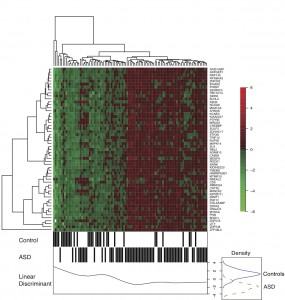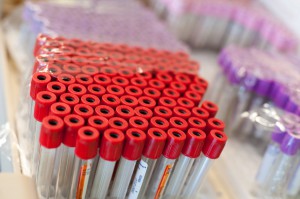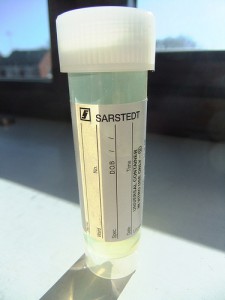
Just about any measurable molecule that changes with health and disease could be a biomarker. (David Guo's Master/Flickr)
Your doctor has a lot of tools to detect, diagnose and monitor disease: x-rays, MRIs, angiography, blood tests, biopsies…the list goes on.
What would be great would be the ability to test for disease in a way where there’s no or low pain (not invasive) and lots of gain (actionable data about the disease process itself, its progression and the success of treatment).
That’s where biomarkers come in.
Just about anything produced by the body could be a biomarker—an indicator of a normal or abnormal disease process—as long as it’s measurable and changes in relationship to disease—for example, going up if the disease gets worse and down if it responds to treatment.
The concept of the biomarker isn’t exactly new. What is cholesterol, after all, if not a biomarker for cardiovascular disease? And blood sugar, if not a marker for diabetes?
Some biomarkers have proven more successful than others. Prostate-specific antigen and CA-125 are proteins detectable in blood that have long been used as biomarkers for prostate and ovarian cancer, respectively, but their effectiveness is under a lot of scrutiny.
But with all of the “-omes” being cataloged and studied today (genome, proteome, etc.), the biomarker field looks to be entering a renaissance.
“Biomarkers is where translational or “bench to bedside” research is moving now,” says David Briscoe, MD, who directs Boston Children’s Transplant Research Program. “What’s nice about them is that for the most part, every disease can be its own control and have a baseline. I think that what we will find over time is that it’s not the absolute measurement of a biomarker but rather the trend that matters as we monitor patients, prevent anticipated disease or even treat a disease process.
“For instance, you could have someone who’s small and thin and who has a creatinine level of 0.4 that then goes up to 0.8,” Briscoe explains. “That’s still a low creatinine level in general, but for this patient it’s doubled. That’s reflective of a significant change, of 50 percent of that patient’s kidney function. In the case of transplantation, we believe that the behavior of more robust disease-specific biomarkers, measured over time, will be the guide for a change in the administration of medication or its efficacy in targeting a disease or it could give clues as to when more invasive investigation is needed.”
More -omes, more regulatory clout, more biomarkers
The FDA, through its Critical Path Initiative, has for nearly nine years been calling on drug companies to incorporate biomarkers in their R&D pipelines, and has placed greater emphasis on biomarker data in drug approval applications. “Companion diagnostics”—really just biomarkers by another name—have thus become big business, as diagnostic and drug companies develop screening tests tied to new targeted drugs.
Cancer tends to be a hotspot of biomarker research, generally because the current methods for measuring treatment response and keeping an eye out for recurrence tend to be invasive and/or expensive. Boston Children’s Marsha Moses, MD, who directs the Vascular Biology Program, has worked for years on urine-based biomarker tests for breast cancer. Her colleague Bruce Zetter, PhD, is working on urine biomarkers for bladder cancer, as well as blood-borne markers for prostate and non-small cell lung cancers. And Edward Smith, MD, a neurosurgeon Moses mentored, wants to use urine proteins to keep an eye on brain tumors.
(Why all this focus on urine? “The body uses the urine as a sink to dispose of excess or unwanted proteins,” says Hanno Steen, PhD, director of Boston Children’s Proteomics Center. “Which means that in addition to being easy to collect, urine is likely to be enriched for inflammatory or disease-related proteins.”)
But cancers aren’t the only center of attention in the biomarker hunt. A few years ago, Steen and Alex Kentsis, MD, PhD, pinpointed a pattern of proteins that could one day serve as biomarkers for diagnosing acute appendicitis; they recently made a similar discovery in a rare and elusive inflammatory condition called Kawasaki disease. A pattern of three blood proteins Briscoe and colleague Kevin Daly, MD, recently found may give cardiologists early warning of chronic organ rejection in the years following a heart transplant. And urologist Richard Lee, MD, is working on urine diagnostics to identify children with conditions requiring surgical interventions or antibiotics without subjecting them to invasive imaging tests.
Proteins aren’t the only name in the game: genes and microbes as biomarkers
Biomark’ers aren’t all about proteins, either. Gene mutations and alterations in gene activity often cluster into specific, measurable signatures. They’re the fuel that’s driving the personalized medicine explosion in cancer and a wide range of chronic diseases.

Gene expression signatures, like the one visualized in this heat map, can help track disease progression and treatment response.
Late last year, for example, a research team led by Isaac Kohane, MD, PhD, Louis Kunkel, PhD, and Leonard Rappaport, MD, MS, described a 55-gene signature that can tell children with and without autism spectrum disorders apart with 70 percent accuracy, via a blood test. The signature captures disruptions in multiple biological pathways, identifying children at risk who might benefit from early intervention.
Even the bacteria that populate our bodies may serve as biomarkers. Researchers including Michael Docktor, MD, and Athos Bousvaros, MD, PhD, of Boston Children’s IBD Center have mapped out the ways in which the gut microbiome changes in children with Crohn’s or ulcerative colitis, and shown that they can use it to tell the two conditions apart. They’ve even been able to use changes in the bacteria in a patient’s mouth—their oral microbiome—to tell these intestinal conditions apart with a simple mouth swab.
Data breed biomarkers
Despite all the data available from -omic and other technologies, the biggest stumbling block to more widespread use of biomarkers in pediatric care is, ironically, a lack of data. But it’s a gap Briscoe is confidant will be closed. “Everyone wants to see biomarkers move more into the clinic,” Briscoe says. “But we need more studies because there is so little data on biomarkers in pediatric patients compared with adults. To promote clinical excellence, we need to have biomarkers for all.”
Want to learn more about biomarker innovations at Boston Children’s? Visit our Technology and Innovation Development Office, where you can find more information about biomarkers like those for appendicitis and Kawasaki disease.









